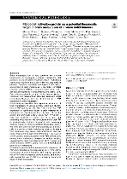| dc.contributor.author | Zubaľ, Michal | |
| dc.contributor.author | Výmolová, Barbora | |
| dc.contributor.author | Matrasová, Ivana | |
| dc.contributor.author | Výmola, Petr | |
| dc.contributor.author | Vepřková, Jana | |
| dc.contributor.author | Syrůček, Martin | |
| dc.contributor.author | Tomáš, Robert | |
| dc.contributor.author | Vaníčková, Zdislava | |
| dc.contributor.author | Křepela, Evžen | |
| dc.contributor.author | Konečná, Dora | |
| dc.contributor.author | Bušek, Petr | |
| dc.contributor.author | Šedo, Aleksi | |
| dc.date.accessioned | 2023-12-18T12:10:40Z | |
| dc.date.available | 2023-12-18T12:10:40Z | |
| dc.date.issued | 2023 | |
| dc.identifier.uri | https://hdl.handle.net/20.500.14178/2128 | |
| dc.description.abstract | Brain metastases are a very common and serious complication of oncological diseases. Despite the vast progress in multimodality treatment, brain metastases significantly decrease the quality of life and prognosis of patients. Therefore, identifying new targets in the micro-environment of brain metastases is desirable. Fibroblast activation protein (FAP) is a transmembrane serine proteae typically expressed in tumour-associated stromal cells. Due to its characteristic presence in the tumour microen-vironment, FAP represents an attractive theranostic target in oncology. However, there is little information on FAP expression in brain metastases.In this study, we quantified FAP expression in samples of brain metastases of various primary origin and charac-terised FAP-expressing cells. We have shown that FAP expression is significantly higher in brain metastases in comparison to non-tumorous brain tissues, both at the protein and enzymatic activity levels. FAP immunopositivity was localised in regions rich in collagen and containing blood vessels. We have further shown that FAP is predominantly confined to stromal cells expressing markers typical of cancer-associated fibroblasts (CAFs). We have also observed FAP immunopositivity on tumour cells in a portion of brain metastases, mainly originating from melanoma, lung, breast, and renal cancer, and sar-coma. There were no significant differences in the quantity of FAP protein, enzymatic activity, and FAP+ stromal cells among brain metastasis samples of various origins, suggesting that there is no association of FAP expression and/or presence of FAP+ stromal cell with the histological type of brain metastases.In summary, we are the first to establish the expression of FAP and characterise FAP-expressing cells in the micro-environment of brain metastases. The frequent upregula-tion of FAP and its presence on both stromal and tumour cells support the use of FAP as a promising theranostic target in brain metastases. | en |
| dc.language.iso | en | |
| dc.relation.url | https://doi.org/10.1016/j.pathol.2023.05.003 | |
| dc.rights | Creative Commons Uveďte původ 4.0 International | cs |
| dc.rights | Creative Commons Attribution 4.0 International | en |
| dc.title | Fibroblast activation protein as a potential theranostic target in brain metastases of diverse solid tumours | en |
| dcterms.accessRights | openAccess | |
| dcterms.license | https://creativecommons.org/licenses/by/4.0/legalcode | |
| dc.date.updated | 2023-12-18T12:10:40Z | |
| dc.subject.keyword | Brain metastases | en |
| dc.subject.keyword | tumour stroma | en |
| dc.subject.keyword | fibroblast activation protein | en |
| dc.subject.keyword | cancer-associated fibroblasts | en |
| dc.subject.keyword | theranostics | en |
| dc.subject.keyword | | en |
| dc.relation.fundingReference | info:eu-repo/grantAgreement/MZ0/NU/NU22-03-00318 | |
| dc.relation.fundingReference | info:eu-repo/grantAgreement/UK/GAUK/GAUK342522 | |
| dc.relation.fundingReference | info:eu-repo/grantAgreement/MSM/LM/LM2023053 | |
| dc.relation.fundingReference | info:eu-repo/grantAgreement/MSM/EF/EF16_019/0000785 | |
| dc.relation.fundingReference | info:eu-repo/grantAgreement/MSM/OP VVV/CZ.02.1.01/0.0/0.0/16_019/0000785 | |
| dc.relation.fundingReference | info:eu-repo/grantAgreement/UK/COOP/COOP | |
| dc.relation.fundingReference | info:eu-repo/grantAgreement/MSM//LX22NPO5102 | |
| dc.date.embargoStartDate | 2023-12-18 | |
| dc.type.obd | 73 | |
| dc.type.version | info:eu-repo/semantics/publishedVersion | |
| dc.identifier.doi | 10.1016/j.pathol.2023.05.003 | |
| dc.identifier.utWos | 001080429100001 | |
| dc.identifier.eidScopus | 2-s2.0-85164441338 | |
| dc.identifier.obd | 637563 | |
| dc.identifier.pubmed | 37419841 | |
| dc.subject.rivPrimary | 30000::30200::30204 | |
| dcterms.isPartOf.name | Pathology | |
| dcterms.isPartOf.issn | 0031-3025 | |
| dcterms.isPartOf.journalYear | 2023 | |
| dcterms.isPartOf.journalVolume | 55 | |
| dcterms.isPartOf.journalIssue | 6 | |
| uk.faculty.primaryId | 108 | |
| uk.faculty.primaryName | 1. lékařská fakulta | cs |
| uk.faculty.primaryName | First Faculty of Medicine | en |
| uk.department.primaryId | 1492 | |
| uk.department.primaryName | Ústav biochemie a experimentální onkologie 1. LF UK | cs |
| uk.department.primaryName | Institute of Biochemistry and Experimental Oncology | en |
| uk.department.secondaryId | 1468 | |
| uk.department.secondaryId | 1538 | |
| uk.department.secondaryName | Neurochirurgická a neuroonkologická klinika 1. LF UK a ÚVN | cs |
| uk.department.secondaryName | Department of Neurosurgery and Neurooncology First Faculty of Medicine Charles University and Mil... | en |
| uk.department.secondaryName | Ústav lékařské biochemie a laboratorní diagnostiky 1. LF UK a VFN | cs |
| uk.department.secondaryName | Institute of Medical Biochemistry and Laboratory Diagnostics | en |
| dc.description.pageRange | 806-817 | |
| dc.type.obdHierarchyCs | ČLÁNEK V ČASOPISU::článek v časopisu::původní článek | cs |
| dc.type.obdHierarchyEn | JOURNAL ARTICLE::journal article::original article | en |
| dc.type.obdHierarchyCode | 73::152::206 | en |
| uk.displayTitle | Fibroblast activation protein as a potential theranostic target in brain metastases of diverse solid tumours | en |

